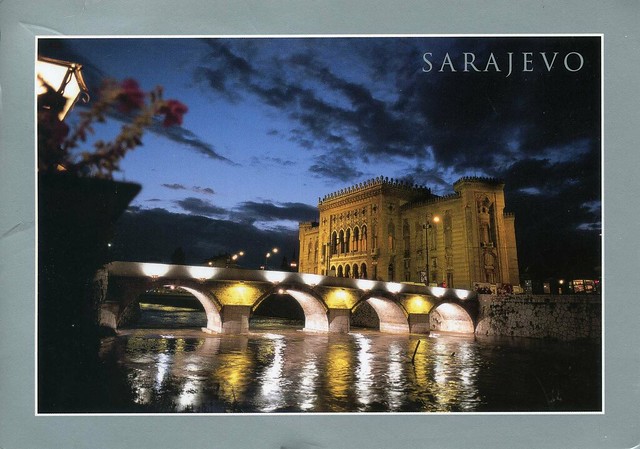I really like food-related postcards but for some reason don't post them in this blog too often.. hhmmmm... This one is from my dear Snježana. Makes me hungry!
Ćevapi is a grilled dish of minced meat, a type of kebab, found traditionally in the countries of southeastern Europe. They are considered a national dish in Bulgaria, Bosnia and Herzegovina and in Serbia. They are also common in Croatia, Montenegro, Kosovo, Slovenia, as well as in Republic of Macedonia, Romania, Czech Republic, Slovakia, Austria and the Italian provinces bordering Slovenia.
They are usually served of 5-10 pieces on a plate or in a flatbread (lepinje or somun), often with chopped onions, sour cream, kajmak, ajvar, cottage cheese, minced red pepper and salt. Serb ćevapčići are made of either beef, lamb or pork or mixed. Bosnian ćevapi are made from two types of minced beef meat, hand mixed and formed with a funnel, while formed ćevapi are grilled. Macedonian, Croatian, Bulgarian and Romanian varieties are often made of both pork and beef. (This is from Wikipedia, correct me if I'm wrong.)
I tried making some ćevapi at home a few weeks ago. I have no idea if it was authentic at all but it was definitely very, very tasty. If anyone reading this has a recipe for proper ćevapi, I'd be more than happy to have it!! (*hint hint*)
Showing posts with label sarajevo. Show all posts
Showing posts with label sarajevo. Show all posts
Wednesday, 1 August 2012
Sunday, 12 September 2010
Sarajevo, Bosnia and Herzegovina
Another postcard from Snjezana...

Sarajevo is the capital and largest city of Bosnia and Herzegovina, 305,242 people in the four municipalities that make up the city proper. It is also the capital of the Federation of Bosnia and Herzegovina entity, as well as the center of the Sarajevo Canton. Sarajevo is located in the Sarajevo valley of Bosnia, surrounded by the Dinaric Alps and situated around the Miljacka river.
The city is famous for its traditional religious diversity, with adherents of Islam, Orthodoxy, Catholicism and Judaism coexisting there for centuries. Due to this long and rich history of religious diversity and coexistence Sarajevo has often been called the "Jerusalem of Europe". Snjezana tells me that the city reflects the old blended with new, and that it's very much like Middle-Eastern city but still it's a modern European city where you can get what you want.
When I hear the name Sarajevo, the first thing that comes to mind is Zlata Filipović and her book Zlata's Diary. I remember reading it when I was young, and it really struck me. That someone so young should live through such horrors, it's not right. I'm very lucky in that I've always lived in such safe countries. No matter how much I dislike some aspects here, at least I don't have to fear for my life or worry about the most basic needs.

And here are the stamps.. the potato one is the same definitive as in the previous post. I couldn't find any info about the top two stamps, so all I know is that they were issued in 2005. EDIT: Ana gave me some more info :) The top stamp is from a set of 4 stamps from 2005, representing the history of BiH and this stamp features the Bosnian ban Kulin.

Sarajevo is the capital and largest city of Bosnia and Herzegovina, 305,242 people in the four municipalities that make up the city proper. It is also the capital of the Federation of Bosnia and Herzegovina entity, as well as the center of the Sarajevo Canton. Sarajevo is located in the Sarajevo valley of Bosnia, surrounded by the Dinaric Alps and situated around the Miljacka river.
The city is famous for its traditional religious diversity, with adherents of Islam, Orthodoxy, Catholicism and Judaism coexisting there for centuries. Due to this long and rich history of religious diversity and coexistence Sarajevo has often been called the "Jerusalem of Europe". Snjezana tells me that the city reflects the old blended with new, and that it's very much like Middle-Eastern city but still it's a modern European city where you can get what you want.
When I hear the name Sarajevo, the first thing that comes to mind is Zlata Filipović and her book Zlata's Diary. I remember reading it when I was young, and it really struck me. That someone so young should live through such horrors, it's not right. I'm very lucky in that I've always lived in such safe countries. No matter how much I dislike some aspects here, at least I don't have to fear for my life or worry about the most basic needs.

And here are the stamps.. the potato one is the same definitive as in the previous post. I couldn't find any info about the top two stamps, so all I know is that they were issued in 2005. EDIT: Ana gave me some more info :) The top stamp is from a set of 4 stamps from 2005, representing the history of BiH and this stamp features the Bosnian ban Kulin.
Subscribe to:
Posts (Atom)





 Maroon
Maroon 









































































































































































